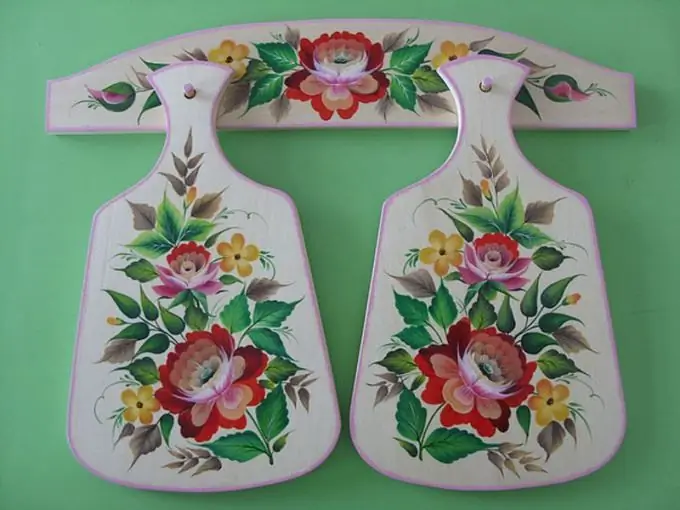An original and heartily made gift for any occasion can be a wooden board with an author's painting. Such a gift will decorate the kitchen, while being very practical, because the board can be used for its intended purpose.

The undoubted advantage of this gift is that it can accurately take into account the tastes of the person being gifted, depicting exactly what he likes on the board. It does not take much time to paint and prepare for it, but this process is very exciting, and most likely, the experiment will want to be repeated.
A wooden board will be needed, since not all paints will fall on the plastic, and it will be more difficult to choose a varnish for coating. It is best to choose a board that is not varnished and unpolished, it is much easier to work with such a surface, and its price is lower. This is an important factor, since the result may not be so good the first or even the second time.
You can take any paints - watercolor, gouache, acrylic or oil will do. But it is most convenient to work with oil or acrylic: watercolor will require several layers of application, since it is a transparent paint, gouache brightens after drying, and both of these paints are washed off with water and spread out during the varnishing process. Some drawings may be very suitable for just such an effect, so you should not completely dismiss these options. Oil paints dry for a long time, but then they will stick on the board almost forever, even without varnish. Acrylic can also not be varnished, but from prolonged exposure to water, the drawing may lose contact with the surface and separate from it in the form of a solid film.
Brushes are chosen depending on the chosen paint. Synthetics are preferable to work with oil and acrylic, but bristles will work too. Soft natural brushes such as squirrel or kolinka are not used. With gouache and watercolors, you can use any brushes.
The surface of the board is thoroughly washed, if necessary, they pass over it with fine emery, if there are many irregularities on it, then wipe with a clean cloth and dry. The drawing can be previously applied to the board with a pencil and painted according to the outlined contour, or you can draw immediately with paints on the board.
First, large elements and general outlines are drawn, if there is a background, then first of all they make it. After each layer, the board should dry out, which slows down the work only when painting with oil, since watercolor, acrylic and gouache dry almost instantly, sometimes leaving no chance to correct the wrong line.
At the same time, whenever possible, colors from light to dark are used, unless the painting is on a black background. The smallest elements that complement the pattern, regardless of color, are made last, before varnishing or final drying. When varnished, the pattern becomes darker and more contrasting. After 5-6 superimposed layers, it gains volume. Each layer must dry completely before applying the next. The varnish is best applied with a brush in a thin layer so that it dries faster. Thick layers often deform when dry, wrinkles or bubbles appear on them, so it is better to apply several thin layers.






